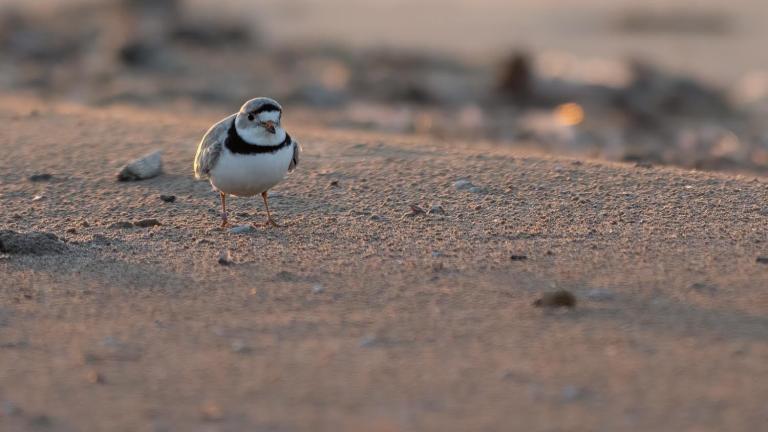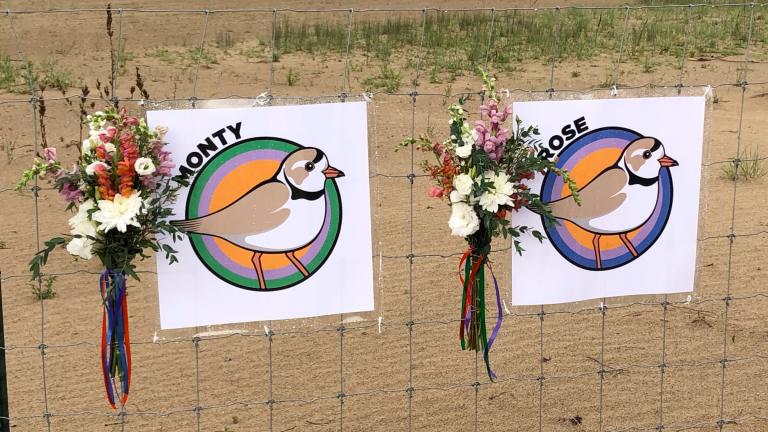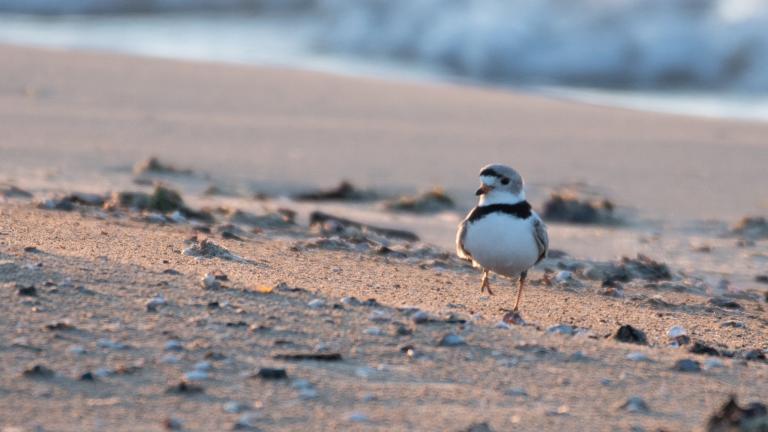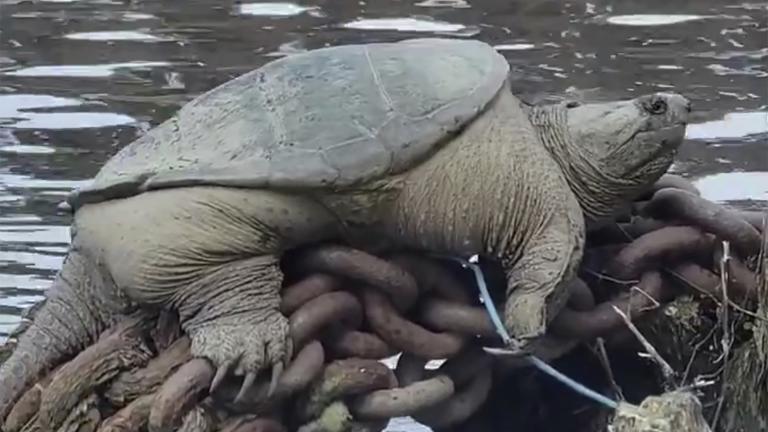Video: Joining “Chicago Tonight” to discuss the piping plovers is Armand Cann, fish and wildlife biologist with the U.S. Fish and Wildlife Service. (Produced by Acacia Hernández)
Imani, Chicago’s resident piping plover, has spent the summer solo on Montrose Beach. Now, the city’s population of the endangered bird has spiked thanks to three new residents.
Three piping plover chicks were released into the wild Wednesday afternoon at the protected Montrose Point Bird Sanctuary in an effort to aid the species in its recovery. Wednesday marks the first time plovers have been released in the state.
Tamima Itani, the lead volunteer coordinator of Chicago Piping Plovers, said the three birds have been named after plants native to Illinois: Searocket, Prickly Pear and Wild Indigo.
They join Imani, the former lone plover at the beach, who has been living a quiet bachelor life after two unidentified plovers — a male and a female — joined him in late April, only to leave about a week later.
It has yet to be determined whether these new plovers are male or female.
Armand Cann, fish and wildlife biologist with the U.S. Fish and Wildlife Service, said the chicks are not strictly being released for Imani, but the hope is they will be more likely to return to the area next year when they’re able to breed.
“Hopefully, if there’s a female, maybe they pair up with Imani, maybe they pair up with another male but we would love to see another successful breeding pair at this beach or elsewhere in Illinois as well,” Cann said.
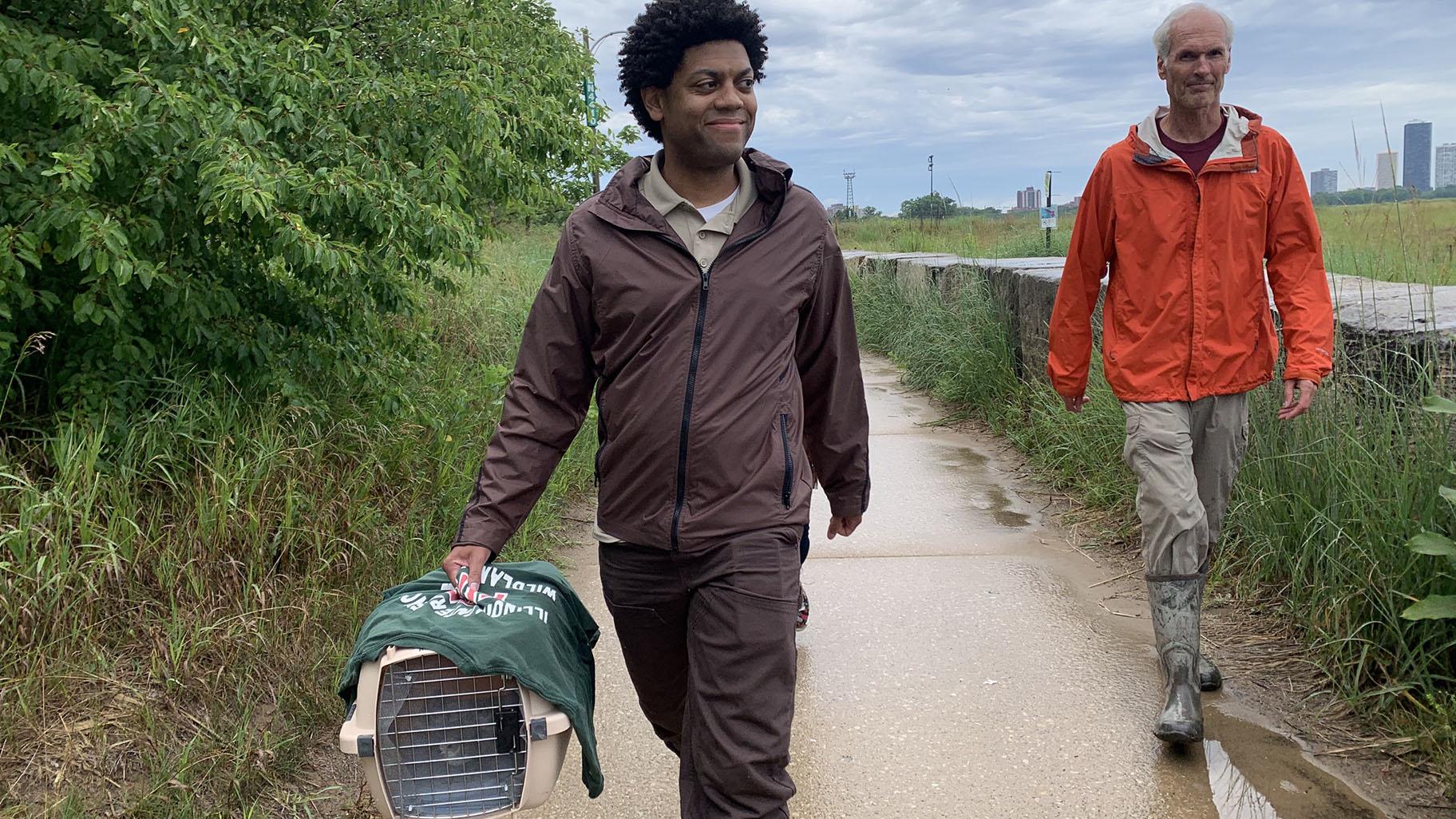 Armand Cann, fish and wildlife biologist with the U.S. Fish and Wildlife Service, left, and Brad Semel, engaged species recovery specialist for the Illinois Department of Natural Resources, walk along a protected site at Montrose Beach ahead of the release of three plovers on July 12, 2023. (Eunice Alpasan / WTTW News)
Armand Cann, fish and wildlife biologist with the U.S. Fish and Wildlife Service, left, and Brad Semel, engaged species recovery specialist for the Illinois Department of Natural Resources, walk along a protected site at Montrose Beach ahead of the release of three plovers on July 12, 2023. (Eunice Alpasan / WTTW News)
Imani is the son of Monty and Rose, who turned up at Montrose Beach in 2019 on their own, capturing the hearts and minds of residents, especially those in the bird watching community. The couple reared three successive broods of chicks.
However, last year, Rose didn’t appear for the couple’s annual spring reunion, and Monty suddenly died at Montrose in May of what was later determined to be a fungal infection.
The release of the newest birds was a joint effort by the U.S. Fish and Wildlife Service, Illinois Department of Natural Resources and the Chicago Park District.
Four other plovers are also planned to be released later Wednesday at Illinois Beach State Park in Zion, according to Brad Semel, engaged species recovery specialist for the Illinois Department of Natural Resources.
Volunteers with the Chicago Piping Plovers immediately began to monitor the city’s newest celebrities following their release. The group plans on having volunteers every day to watch the birds in two-hour shifts from 6 a.m. to 8 p.m., Itani said.
“They’ll be migrating south and we want them to leave with as much good Midwestern fat as possible,” Itani said.
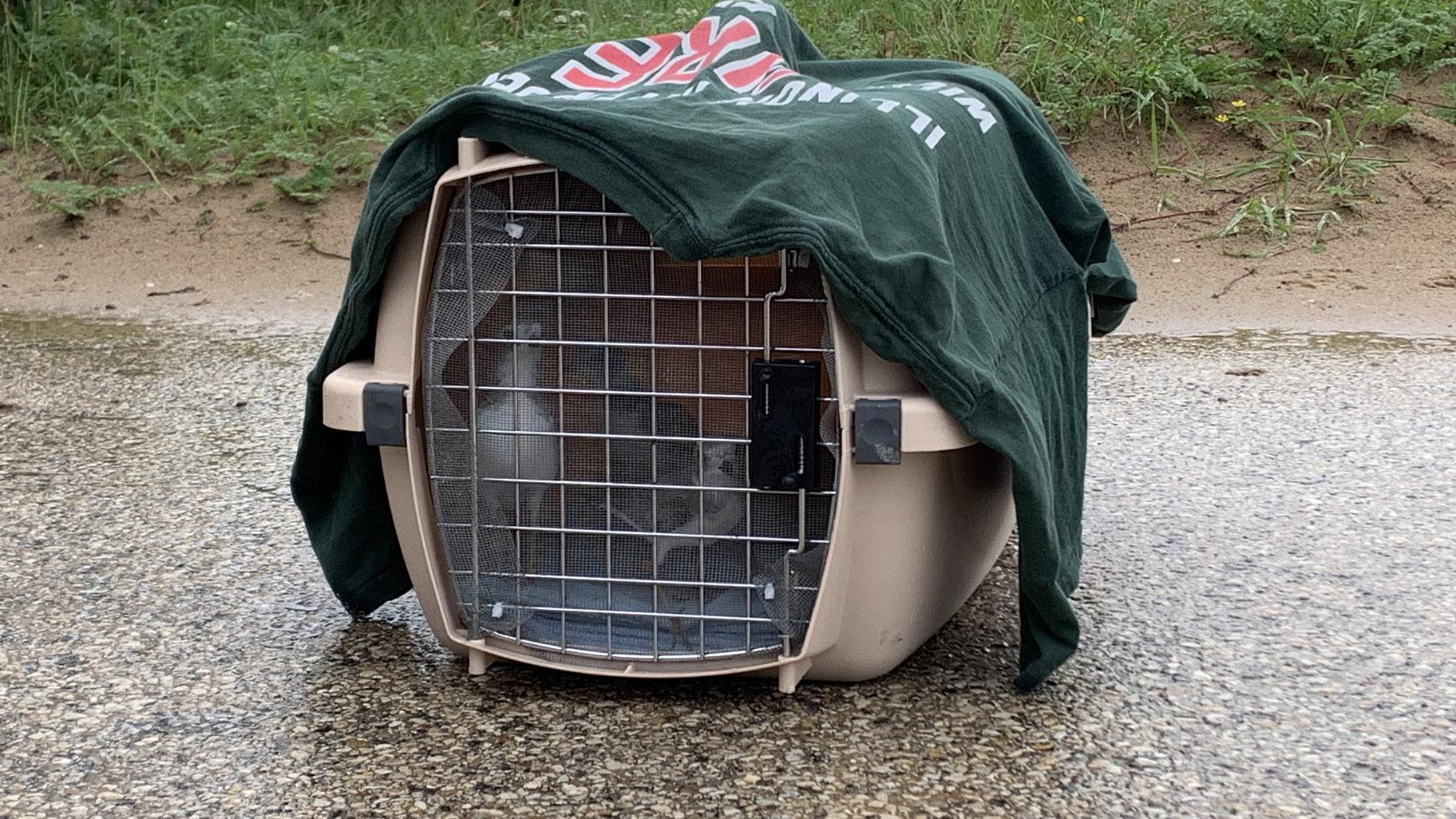 The three piping plovers released at Montrose Point Bird Sanctuary on July 12, 2023, have been named after plants native to Illinois: Searocket, Prickly Pear and Wild Indigo. (Eunice Alpasan / WTTW News)
The three piping plovers released at Montrose Point Bird Sanctuary on July 12, 2023, have been named after plants native to Illinois: Searocket, Prickly Pear and Wild Indigo. (Eunice Alpasan / WTTW News)
Searocket, Prickly Pear and Wild Indigo are about five weeks old. They were captive chicks hailing from New York. The chicks were rescued from the wild in the spring to be raised in captivity because of nest abandonment following the death of a parent plover.
The Great Lakes piping plover population was listed as federally endangered in 1986. The Great Lakes Piping Plover Recovery Effort reported 80 breeding pairs with 61 active broods or nests, as of July 5.
The U.S. Fish and Wildlife Service advises following some specific steps in order to share the beach with piping plovers and help them survive:
- Watch these entertaining birds from a distance.
- If pets are permitted on beaches, keep them leashed and away from birds.
- Remove trash and food scraps, which attract animals that might eat piping plovers and their eggs.
- Do not feed animals on or near the beach. Keep your cats indoors.
- Volunteer as a piping plover monitor, ambassador or educator on your local beach. Tell your friends and family how to help.
When people get too close to birds, they flush (fly off their nests or move away from feeding areas), the U.S. Fish and Wildlife Service said. While it might seem minor, this drives birds away from what they need to survive: food and a resting place. Imagine if you were hungry and tired, and forces beyond your control kept you away from food all day without a place that felt safe to rest.
“The reason we got these captive, rearing piping plover chicks is because how welcoming Chicago was to Monty and Rose and to their chicks, and how warmly everyone embraced the piping plovers,” Itani said. “We have a great example of Midwestern hospitality here.”
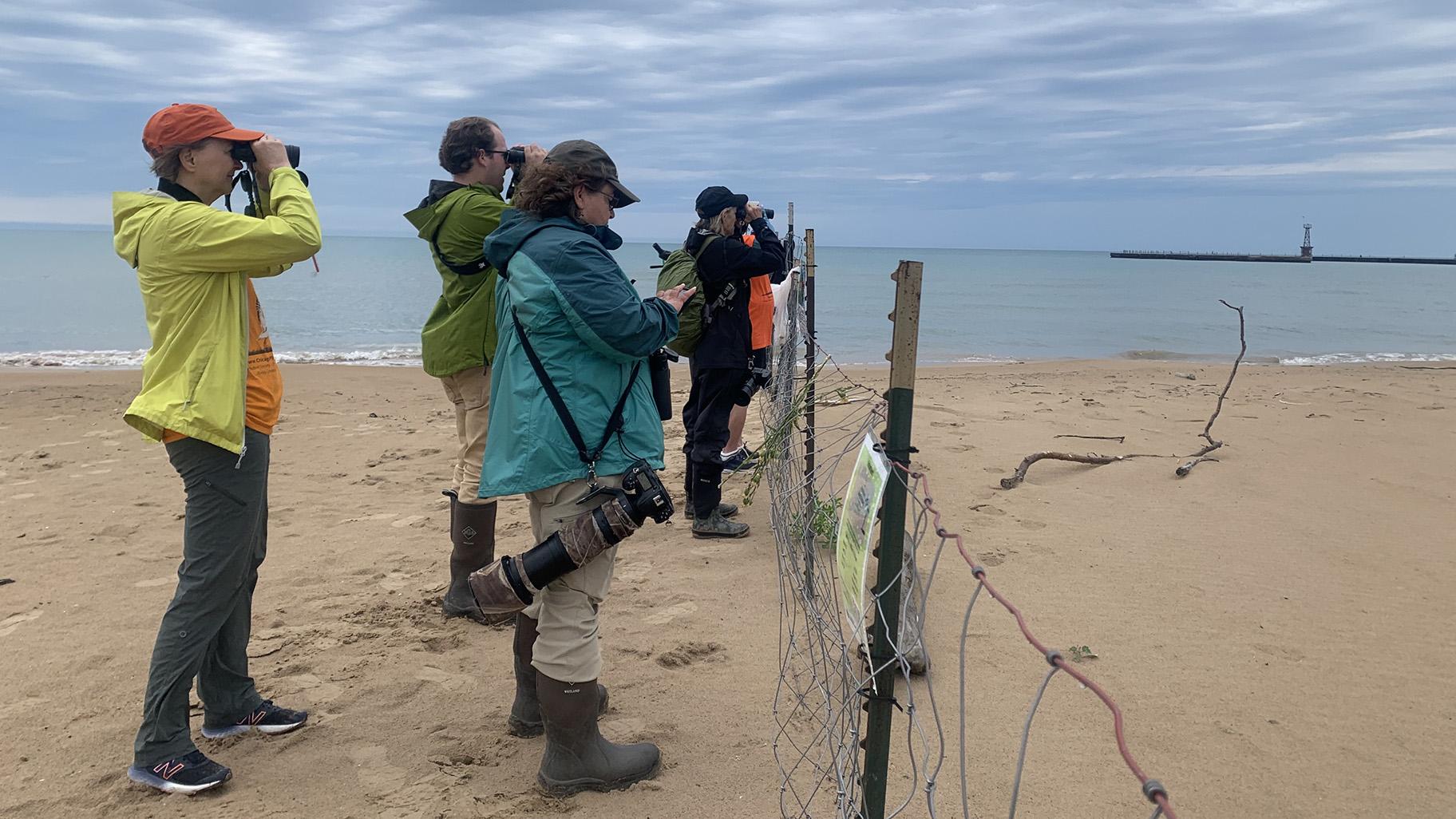 Birding enthusiasts and volunteers with the Chicago Piping Plovers group gather to monitor piping plovers at Montrose following the release of three new plovers July 12, 2023. (Eunice Alpasan / WTTW News)
Birding enthusiasts and volunteers with the Chicago Piping Plovers group gather to monitor piping plovers at Montrose following the release of three new plovers July 12, 2023. (Eunice Alpasan / WTTW News)

